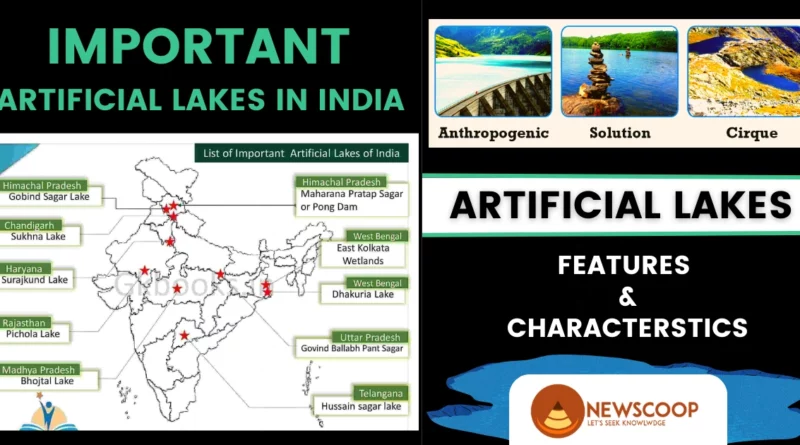List of Artificial Lakes in India: Examples of Manmade Lake with Map
India, a land blessed with diverse landscapes and abundant natural resources, is home to numerous artificial lakes that exemplify the harmonious coexistence of nature and human intervention. These man-made marvels serve as valuable assets, fulfilling multiple purposes such as water storage, irrigation, hydroelectric power generation, tourism, and recreational activities.
In this article, we will explore the world of manmade or artificial lakes in India, providing examples and information about their formation. This knowledge is crucial for Geography preparation in the UPSC Civil Services Exam, and we’ll also include a map for visual reference.
| Periyar Lake | Govind Sagar |
| Bhojtal Lake | Sukhna Lake |
| Vembanad lake | Bhimtal Lake |
| Nagarjuna Sagar | HiraKund Lake |
What are Artificial Lakes?
Artificial lakes, also known as man-made or human-made lakes, are bodies of water that are created or modified by human activities. These lakes are deliberately constructed by impounding water through the construction of dams, reservoirs, or other water control structures. Unlike natural lakes that form through natural processes, artificial lakes are intentionally designed and built to fulfill specific purposes such as water storage, irrigation, flood control, power generation, or recreation.
How are Artificial Lakes Formed?
- Select a suitable location for the lake.
- Construct a dam or embankment across a river or stream to impound water.
- Excavate and clear the site if necessary.
- Shape the land to create the desired depth and configuration for the lake.
- Build spillways and outlets to control water levels and regulate flow.
- Fill the reservoir by diverting water from rivers or capturing rainfall runoff.
- Regularly manage and maintain the lake to ensure its proper functioning.
Artificial Lakes in India
Here is a list of notable artificial lakes in India:
- Periyar Lake
- Bhojtal Lake
- Govind Sagar
- Bhimtal Lake
- Sukhna Lake
- HiraKund Lake
- Nagarjuna Sagar
- Rana Pratap Sagar
- Vembanad lake
Periyar Lake
- Periyar Lake is a man-made reservoir located in Thekkady, Kerala.
- It was formed by the construction of the Mullaperiyar Dam across the Periyar River.
- The lake covers an area of approximately 26 square kilometers.
- It is a freshwater lake.
- It is a significant water source for irrigation and drinking water supply to nearby towns and villages.
- Periyar Lake is surrounded by the Periyar National Park, a renowned wildlife sanctuary known for its diverse flora and fauna.
- The Periyar Tiger Reserve, located near the lake, is a popular destination for wildlife enthusiasts and nature lovers.
- The lake and its surrounding areas are protected and managed by the Periyar Wildlife Sanctuary authorities.
Bhojtal Lake
- Bhojtal Lake is a large artificial lake located in Bhopal, the capital city of Madhya Pradesh, India.
- Bhojtal Lake, also known as Upper Lake.
- It was created in the 11th century by King Bhoja of the Paramara dynasty, and it is named after him.
- Bhojtal Lake is one of the oldest man-made lakes in India, with a history dating back over a thousand years.
- It is a freshwater lake.
- The lake covers an area of approximately 31 square kilometers, making it one of the largest artificial lakes in the country.
- The water of Bhojtal Lake is considered sacred and is used for religious ceremonies and rituals during festivals like Holi and Navratri.
Govind Sagar
- Govind Sagar is the largest artificial lake situated in the Bilaspur district of Himachal Pradesh, India.
- It was created by the construction of the Bhakra Dam on the Sutlej River.
- The reservoir is named after Guru Govind Singh, the tenth Sikh Guru.
- Govind Sagar has a surface area of around 168 square kilometers, making it one of the largest reservoirs in India.
- The lake serves as a vital water storage facility, providing water for irrigation, hydropower generation, and drinking water supply to various regions.
- It is a key component of the Bhakra Nangal Project, which is one of the largest multipurpose river valley projects in India.
Bhimtal Lake
- Bhimtal Lake is a beautiful freshwater lake located in the town of Bhimtal in the Nainital district of Uttarakhand, India.
- It is named after Bhima, one of the Pandava brothers from the Hindu epic Mahabharata.
- Bhimtal Lake is the largest lake in the Kumaon region and holds historical and mythological significance.
- The lake spans an area of about 47.5 hectares and has an average depth of 18 meters.
- It is a freshwater lake.
- It is surrounded by lush green hills and offers a serene and picturesque setting for visitors.
- Bhimtal Lake is known for its island in the center, which houses a beautiful aquarium called the Bhimtal Island Aquarium.
- It is home to a variety of fish species, making it an attractive spot for anglers.
- The Bhimeshwar Mahadev Temple, dedicated to Lord Shiva, is situated on the eastern bank of the lake and attracts devotees and tourists.
Sukhna Lake
- Sukhna Lake is a man-made reservoir located in Chandigarh, a union territory in India.
- It was created in 1958 by damming the Sukhna Choe, a seasonal stream flowing from the Shivalik hills.
- The lake covers an area of approximately 3 square kilometers and has a shoreline of around 4 kilometers.
- Sukhna Lake was designed by Le Corbusier, the renowned architect who planned Chandigarh.
- The lake is a popular recreational spot and attracts a large number of visitors, including locals and tourists.
- Boating is a major activity at Sukhna Lake, with pedal boats and rowing boats available for rent.
- The lake is surrounded by a promenade, known as Sukhna Lake Promenade, which provides a scenic walking and jogging path.
- The lake hosts several cultural events and festivals, including the annual Sukhna Lake Festival, which showcases music, dance, and art.
- The Sukhna Wildlife Sanctuary is located in the vicinity of the lake and is a protected area for flora and fauna.
HiraKund Lake
- Hirakud Lake is a large artificial reservoir located in Odisha, India.
- It was created by constructing the Hirakud Dam across the Mahanadi River, one of the major rivers in the state.
- Hirakud Lake is the longest man-made lake in India, stretching over a length of approximately 55 kilometers.
- The lake covers an area of about 743 square kilometers, making it one of the largest reservoirs in the country.
- It serves multiple purposes, including irrigation, hydroelectric power generation, and flood control in the Mahanadi River basin.
- Hirakud Dam, which forms the lake, is one of the earliest major river valley projects in India, completed in 1957.
Nagarjuna Sagar
- Nagarjuna Sagar is a prominent artificial lake and reservoir located in the Guntur district of Andhra Pradesh and the Nalgonda District of Telangana.
- The lake was formed by the construction of the Nagarjuna Sagar Dam on the Krishna River.
- It is one of the largest man-made lakes in the world, covering an area of about 285 square kilometers.
- The reservoir is named after the renowned Buddhist scholar and philosopher Nagarjuna, who lived in the region during ancient times.
- Nagarjuna Sagar serves multiple purposes, including irrigation, hydroelectric power generation, and drinking water supply to various regions.
- The dam and reservoir are part of the Nagarjuna Sagar Project, which was completed in 1969.
- The project has significantly contributed to the agricultural development of the surrounding areas by providing water for irrigation.
- Nearby attractions include the Nagarjuna Sagar Wildlife Sanctuary, where visitors can explore the diverse flora and fauna of the region.
Rana Pratap Sagar
- Maharana Pratap Sagar, formerly known as Pong Reservoir, is a man-made lake located in the Kangra district of Himachal Pradesh, India.
- The reservoir was created by constructing the Pong Dam on the Beas River, one of the major rivers in Himachal Pradesh.
- Maharana Pratap Sagar is named after the renowned Rajput warrior, Maharana Pratap Singh of Mewar.
- The reservoir covers an area of approximately 475 square kilometers, making it one of the largest man-made lakes in India.
- It serves multiple purposes, including irrigation, hydroelectric power generation, and water supply for drinking and industrial use.
- Maharana Pratap Sagar is a designated wildlife sanctuary and is home to a wide variety of flora and fauna, including migratory birds.
Vembanad lake
- Vembanad Lake is the largest lake in the state of Kerala, India.
- It is located in the district of Alappuzha (Alleppey), with parts extending to the districts of Kottayam and Ernakulam.
- The lake spans an area of approximately 2033 square kilometers, making it one of the largest freshwater lakes in India.
- Vembanad Lake is a complex lagoon system formed by several interconnected lakes, canals, and waterways.
- It is fed by several rivers, including the Meenachil, Manimala, and Pamba, and ultimately drains into the Arabian Sea.
- Vembanad Lake is renowned for its backwaters, which attract a significant number of tourists seeking houseboat cruises and serene boating experiences.
- The annual Nehru Trophy Boat Race, a major traditional boat race in Kerala, takes place on Vembanad Lake, attracting participants and spectators from across the state.
- The lake is a designated Ramsar site, recognized internationally for its ecological significance and biodiversity conservation efforts.
Also Read: Types of Lakes
Conclusion
India’s manmade or artificial lakes are not just marvels of engineering and human ingenuity; they are also an integral part of the country’s cultural, ecological, and economic fabric. These man-made reservoirs contribute to water management, support local communities, enhance tourism, and preserve the natural beauty of their respective regions.
As we appreciate the wonders of these artificial lakes, let us also recognize the need for sustainable management and conservation to ensure their longevity for future generations to cherish and enjoy.
Thank You!


Thanks for sharing this information about “Artificial Lakes in India”